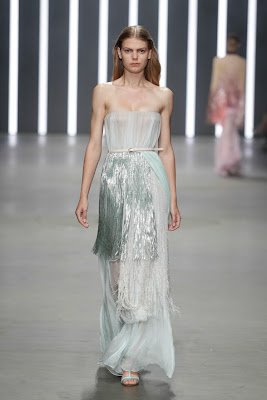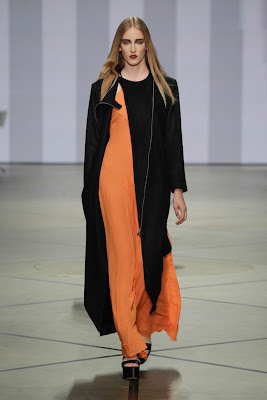SIS by Spijkers & Spijkers
Truus and
Riet Spijkers kicked off Amsterdam Fashion Week. The collection is inspired by the fifties with the young Brigitte Bardot as muse. A classic wardrobe with typical BB plaids, stripes, bare shoulders and wide skirts.
Claes Iversen
Claes Iversen showed a collection inspired by Dutch summer rain. The Danish designer played with diffrent layers, lengths and volumes with beaded sequins like a waterfall of raindrops.
Marga Weimans
Marga Weimans presents a more wearable collection this time, with a visible link to architecture and interior design. The designer worked with artist Jeroen Koolhaas, renowned for his work for Prada, on these particular prints.
Dorhout Mees
The inspiration of
Dorhout Mees comes from a poetry album from 1800 that the designer recently inherited from her grandmother. Full of love, poetry, drawings and embroideries. All in great contrast with the time from now where we hardly have time for each other and personal contact seems strange.
Anne de Grijff
Anne Grijff makes her Fashion Week debut with a collection inspired by Dutch regional dress. Especially the way in which housewives wore their clothing in the beginning of the 18th century. Women at that time folded their linens and laid it over tightly in the closet. This gave a certain kind of pattern. Therewith they showed the outside world where they came from and that they had a tidy household.
Winde Rienstra
Winde Rienstra found her inspiration in the beauty of abandoned Russian dachas. These are wooden houses, where urban Russians spent the sweltering summers. Poetic works of art, with fine carvings and a large variety of shapes and proportions. In former times, the dachas were abandoned during the long Russian winters, making them temporary ice crystals of remembrance. The purity, wealth and serenity of these abandoned places was the inspiration which Winde Rienstra showed the touching vulnerability of human enclosures
Lichting 2013
The prize is awarded every year since 2007 to the most promising graduate collection in the Netherlands. The greatest talents of the seven Dutch fashion academies give a fashion show together to present themselves to the critical fashion press and industry. This year's jury members are fashion editor of The Independent, Alexander Fury, designer and former Lichting winner, Maarten van der Horst, founder of Not Just A Label, Stefan Siegel and Robb Young, fashion consultant and journalist.
A text of Arthur Schopenhauer, a German philosopher, in which he compares the behavior of porcupines with human society inspired
Anna Kathryn Gregor's collection that reflects on human behavior in private and public spaces. Schopenhauer describes the human need for both affection and protection. The natural armor of the porcupine led to deformed body shapes and the usage of elements of safety clothes.
In
Anne van den Boogaard's opinion people live safe and colorless lives. Most people don’t take risks or experience highs or lows. The collection is about the element of surprise, pushing the unexpected and being alive in every way possible. It's about exploring boundaries within the aesthetics of ugliness in an anomalous way.
Wenda Harmsen first highlighted the absurdity of footwear with a heel which seems to disappear into the ground and a toe cap which reaches upward instead forward. It is amazing how she combines oversized silhouettes, checked fabrics and rubber coating.
The collection of
Anbasja Blanken had the symbolic and spiritual values of mystical light as a starting point. In some cases, light was attributed supernatural, divine and spiritual powers. Hence the term ‘enlightened’ women that refer to those who enlighten the spiritual routes of others through their veils. These women have the power to lead humanity to a higher state of consciousness and represent the highest state of holiness.
The winner of Lichting 2013,
Henriëtte Tilanus, made a tribute to eccentric writer Lady Edith Sitwell from the early twenties. The lady showcases her love of art, but also shows a glimpse of loneliness. Loneliness to be a consequence of her misunderstood beautiful creative mind. She translates this into experimental textile operations, like embroidered plastics, hand painted bleached stripes on denim and ripped out threads.










































































